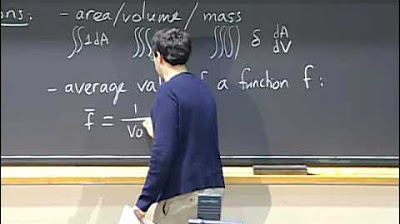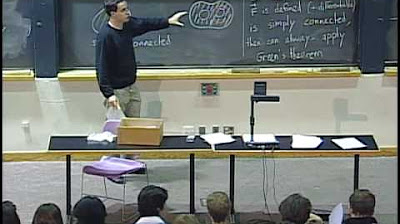Lecture 21: The Fundamental Theorem Extended
TLDRThis video script delves into the fundamental concepts of calculus, starting with the introduction of derivatives and integrals through the analogy of a car moving along a straight road. It then extends these concepts to more complex scenarios, such as motion in a plane and functions of several variables. The script revisits the fundamental theorem of calculus, which links derivatives and integrals, and extends it to cover line integrals and applications in physics, including fluid dynamics and electromagnetism. It also touches on the work of George Green and introduces theorems like the Divergence Theorem, Green's theorem, and Stokes' theorem, highlighting their significance in modern industrial development.
Takeaways
- 🚗 The course began with an introduction to calculus using the example of a car moving along a straight road, illustrating the concept of a real-valued function of one real variable.
- 📈 The derivative and integral were introduced as fundamental calculus concepts, with the derivative representing the rate of change and the integral representing the accumulation of change.
- 📚 The ideas of derivative and integral were extended to more complex situations, such as motion in a plane and functions of several variables, including partial derivatives and double integrals.
- 🧭 The fundamental theorem of calculus was highlighted as a key relationship between derivatives and integrals, stating that the integral of the derivative of a function is equal to the function's net change over an interval.
- 🏞 The concept of extending the fundamental theorem of calculus to more complex scenarios, such as hiking up a mountain slope, was introduced.
- 📏 The script discussed how to determine elevation changes on a mountain slope using surveying methods, which is analogous to the process of integration.
- 📍 The fundamental theorem for line integrals was presented, relating the change in altitude along a path to the integral of the partial derivatives of a function of two variables.
- 🌐 The Divergence Theorem, also known as Gauss's theorem, was mentioned as a variation of the fundamental theorem of calculus, applicable to fluid dynamics and the behavior of gases.
- 🌀 The script touched on other variations of the fundamental theorem, such as Green's theorem and Stokes' theorem, which have significant applications in physics, including fluid flow and electromagnetism.
- 👨🏫 A brief story about George Green was shared, highlighting his self-taught mathematical achievements and the impact of his theorem on the understanding of electricity and magnetism.
Q & A
What is the fundamental object introduced when the course began discussing calculus?
-The fundamental object introduced was the concept of a car's position along a straight road at every moment in time, represented as a real-valued function of one real variable (time).
What does the position function of a car moving on a straight road represent in terms of function terminology?
-In function terminology, the position function represents a real-valued function of one real variable because it gives one number (the position of the car) for each time value.
How are derivatives and integrals initially developed in the course?
-Derivatives and integrals are initially developed for single-valued functions of a single variable, using the idea of the car's position function to explore these concepts.
What is an example of extending the derivative and integral to more complex situations?
-An example given is motion in the plane, such as a car moving on the road or a fly in the air, where time produces two numbers (horizontal and vertical positions), requiring extensions of derivative and integral concepts.
What is the fundamental theorem of calculus, and how does it relate to the concepts of derivative and integral?
-The fundamental theorem of calculus describes the relationship between the derivative and integral, stating that the integral of the derivative of a function from one point to another is equal to the function's value at the end point minus its value at the start point. It can be phrased as 'accumulated change equals net effect'.
How does the concept of surveying relate to the fundamental theorem of calculus?
-Surveying, which involves measuring the change in altitude step by step, is analogous to the process of integration, which accumulates changes to find the total change in altitude or elevation over a path.
What is a topographical map, and how does it relate to functions of two variables?
-A topographical map is a representation of the terrain's elevation at each point. It is a function of two variables because it gives one value (elevation) for every two numbers (X and Y coordinates) provided.
What does the partial derivative of a function with respect to X tell us at a particular point on a map?
-The partial derivative of a function with respect to X at a particular point on a map tells us the slope of the terrain in the X direction at that point, indicating how steep the terrain is if one were to move in that direction.
What is the fundamental theorem for line integrals, and how does it extend the fundamental theorem of calculus?
-The fundamental theorem for line integrals extends the fundamental theorem of calculus to situations involving a path between two points in a two-variable function (like a map). It states that the accumulated change in altitude along a path (found by integrating the partial derivatives along the path) is the same as the net effect, which is the difference in function values (elevation) between the start and end points of the path.
How can the concept of a velocity vector field be used to describe the behavior of fluids and gases?
-A velocity vector field describes the direction and speed of the fluid or gas at each point in space. It is used to model the behavior of fluids and gases by providing a local analysis of how the medium is expanding or contracting at each point.
What is the Divergence Theorem, and how does it relate to the fundamental theorem of calculus?
-The Divergence Theorem, also known as Gauss's theorem, is a variation of the fundamental theorem of calculus that applies to situations where space is bounded by a surface. It relates the local rate of expansion or contraction of a fluid or gas at each point within a region to the net flow of the substance through the bounding surface per unit time, following the principle that accumulated change equals net effect.
Who was George Green, and what is his contribution to the field of mathematics?
-George Green was a self-taught mathematician who worked in his father's bakery and had no formal education. He is known for proving and publishing Green's theorem, which has significant applications in electricity, magnetism, and fluid dynamics. His work contributed to the mathematical theories that underpinned the 20th-century industrial development.
Outlines
🚗 Introduction to Calculus with Car Motion
The video script begins with a review of the course material on calculus, introduced through the example of a car moving along a straight road. The car's position at any given time is represented by a real-valued function of one real variable, which is used to develop the foundational concepts of derivatives and integrals. The instructor emphasizes the extension of these concepts to more complex scenarios, such as motion in a plane and functions of several variables, including partial derivatives and multiple integrals.
📚 Extending the Fundamental Theorem of Calculus
The script then delves into the fundamental theorem of calculus, which relates the derivative and the integral, using the analogy of a car's position and velocity functions. The instructor proposes extending this theorem to more complex situations, such as hiking up a mountain slope, which involves functions of two variables. The concept of a topographical map as a function of two variables is introduced, setting the stage for discussing how to find elevation changes, akin to the fundamental theorem's application in one-variable calculus.
🏞️ Surveying and Calculating Elevation Changes
The third paragraph discusses the historical method of surveying to determine elevation changes on a mountain before the advent of GPS technology. The process involved incremental measurements of rising and falling over short distances to determine the altitude at various points. This method is likened to an integral, as it accumulates changes in altitude along a path. Two strategies for finding elevation differences are presented: direct subtraction from a topographical map or summing incremental changes along a walked path, both of which are reminiscent of the fundamental theorem of calculus.
🧭 Partial Derivatives and Diagonal Path Ascents
This paragraph introduces the concept of partial derivatives in the context of a two-variable function representing terrain elevation. The partial derivatives with respect to x and y indicate the steepness of the terrain in those respective directions. The instructor explains how to calculate the change in altitude when taking a diagonal path by combining the effects of moving in the x and y directions, using the partial derivatives to determine the ascent or descent in each direction.
🌄 The Fundamental Theorem for Line Integrals
The script presents the fundamental theorem for line integrals, which is an extension of the fundamental theorem of calculus to deal with changes in altitude along a path in two-dimensional space. The theorem is explained through the integral of the partial derivatives of a function f(x, y) with respect to x and y, multiplied by the respective path components. The integral accumulates the changes in altitude along the path, which is equivalent to the difference in function values at the start and end points of the path, regardless of the path taken.
💨 Modeling Fluid Dynamics with Calculus
The sixth paragraph explores the application of calculus in modeling fluid dynamics, specifically the behavior of wind. The wind's direction and speed at each point in space are described using a velocity vector field. The Divergence Theorem, a variation of the fundamental theorem of calculus, is introduced as a means to understand the net flow of gas across a containing surface, relating local expansion or contraction rates to the overall volume flow per unit time.
🔍 The Broader Impact of Calculus Theorems
The final paragraph highlights the broader impact of various theorems that extend the fundamental theorem of calculus, such as Green's theorem, the Divergence Theorem (also known as Gauss's theorem), and Stokes' theorem. These theorems have critical applications in fields like fluid dynamics, electricity, and magnetism. The story of George Green, a self-taught mathematician who contributed significantly to these fields, is shared to illustrate the profound impact that mathematical theories can have on industrial development.
Mindmap
Keywords
💡Derivative
💡Integral
💡Real-valued function
💡Partial Derivative
💡Multiple Integrals
💡Fundamental Theorem of Calculus
💡Line Integral
💡Velocity Vector Field
💡Divergence Theorem
💡Green's Theorem
Highlights
Introduction of calculus through the example of a car moving down a straight road.
Fundamental concept of a real-valued function of one real variable to represent the car's position over time.
Development of derivative and integral concepts for single-valued functions of a single variable.
Extension of derivative and integral ideas to more complex functions and situations.
Discussion of motion in a plane with examples of a car and a fly, introducing two-variable functions.
Introduction of partial derivatives to analyze the slope on a two-variable terrain.
Concept of double integrals to calculate volume under a surface, an extension of integral ideas.
Fundamental Theorem of Calculus explaining the relationship between derivatives and integrals.
Application of the Fundamental Theorem of Calculus to more complicated scenarios like mountain slopes.
Explanation of how surveying works as an analogy to the integral concept.
Fundamental Theorem for Line Integrals relating to the change in altitude over a path.
Use of partial derivatives to find the steepness of terrain in different directions.
Example of calculating the ascent in altitude using the fundamental theorem for line integrals.
Discussion on the behavior of fluids and gases, introducing the concept of a velocity vector field.
Introduction of the Divergence Theorem, a variation of the fundamental theorem for enclosed spaces.
Historical account of George Green and his contributions to mathematics and physics.
Explanation of Green's theorem and its significance in the mathematical theories of electricity and magnetism.
Overview of other variations of the fundamental theorem of calculus including Stokes' theorem.
Emphasis on the importance of accumulated change equaling net effect in understanding physics.
Upcoming lectures to explore further applications and strategies for applying calculus in various domains.
Transcripts
Browse More Related Video

Stokes' Theorem and Green's Theorem

Calculus 3 Final Review (Part 3) || Vector Calculus || Line Integrals, Green's and Stokes' Theorem

Lec 35: Final review (cont.) | MIT 18.02 Multivariable Calculus, Fall 2007

AP Calculus AB Review

What We Must Know for Calculus AB

Lec 24: Simply connected regions; review | MIT 18.02 Multivariable Calculus, Fall 2007
5.0 / 5 (0 votes)
Thanks for rating: